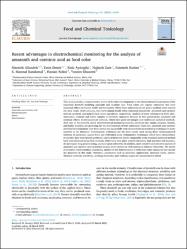Recent advantages in electrochemical monitoring for the analysis of amaranth and carminic acid as food color

Göster/
Erişim
info:eu-repo/semantics/embargoedAccessTarih
18.03.2022Yazar
Alizadeh, MarziehDemir, Ersin
Aydoğdu, Nida
Zare, Najmeh
Karimi, Fatemeh
Kandomal, S Masoud
Rokni, Hassan
Ghasemi, Younes
Üst veri
Tüm öğe kaydını gösterKünye
Alizadeh, M., Demir, E., Aydogdu, N., Zare, N., Karimi, F., Kandomal, S. M., ... & Ghasemi, Y. (2022). Recent advantages in electrochemical monitoring for the analysis of amaranth and carminic acid food colors. Food and Chemical Toxicology, 112929.Özet
This study provides a comprehensive review of the latest developments in the electrochemical impressions of the important dyestuffs including amaranth and carminic acid. Food colors are organic substances that have important effects on human health and food safety. While these substances do not pose a problem when used in the daily intake (ADI) amounts, they harm human health when consumed excessively. Amaranth and carminic acid are synthetic and natural food colors ingredients, respectively. Analysis of these substances in food, pharmaceutical, cosmetic and textile samples is extremely important because of their genotoxicity, cytostatic and cytotoxic effects. Electroanalytical methods, which have great advantages over traditional analytical methods, shed light on the scientific world. Electrochemical monitoring modules, which are fast, simple, accurate, reliable, and highly selective, are promising for the determination of both substances. Until now, amaranth and carminic acid food determinations have been carried out successfully with electrochemical monitoring techniques in many numbers in the literature. Voltammetric techniques are the most widely used among these electroanalytical methods. In particular, square wave and differential pulse voltammetric techniques, which have extraordinary properties, have been heavily preferred. Limits of detection (LOD) comparable to the standard analytical method have been achieved using these methods, which have very quick analysis durations, high precision and accuracy, do not require long preprocessing, and have great selectivity. In addition, more sensitive and selective analyses of amaranth and carminic acid in natural samples were carried out with numerous indicator electrodes. The merits of powerful electrochemical monitoring studies for the determination of both food colors during the last decade are presented in this study. Moreover, parameters such as analytical applications, detection limits, electrochemical methods, selectivity, working electrodes, and working ranges are summarized in detail.















